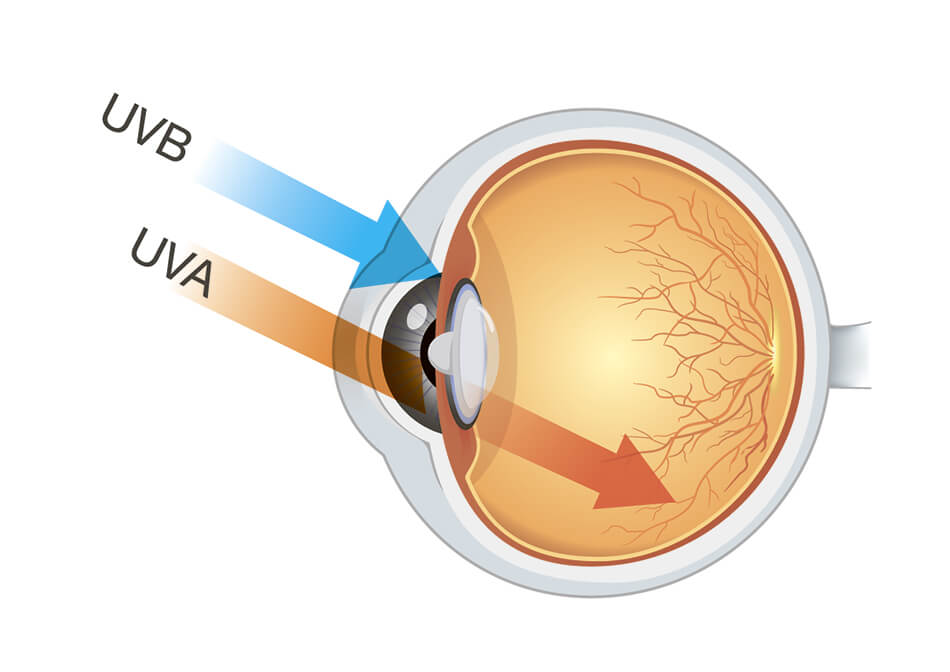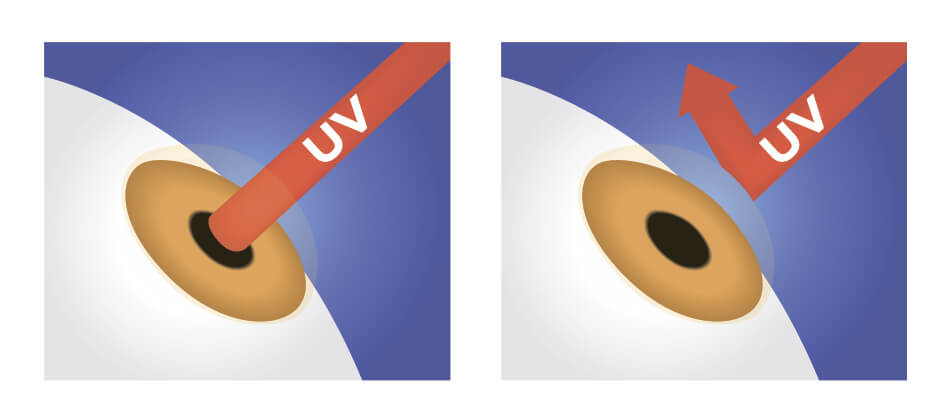Consider Contact Lenses with UV Protection as an Added Defense Against the Sun
We’ve been using sunscreen to protect our skin from the sun’s rays for decades, but what about protecting our eyes? As our awareness of UV damage increases, it’s common to find contact lenses, such as Acuvue, with a degree of UV protection* built in. In fact, Acuvue claims that “No other contact lens has higher UV blocking”. It’s important to take the risk of sun damage to your eyes seriously, and contact lenses can play a key role in how you protect your vision from the sun.
What is UV?
Ultraviolet radiation, or UV, is invisible. It’s a component of sunlight that is also in sources such as tanning beds and lasers. Wearing a hat to protect against the direct rays of the sun is not enough to protect your eyes. Reflected UV light can be just as dangerous! Water reflects 100% of UV rays and snow reflects 85%. Hard surfaces such as concrete, as well as beach sand, can bounce 25% of those damaging rays right into your unprotected eyes. Even on an overcast day, the UV rays may penetrate the clouds. Whether you are out in the sunshine to work or play, you need to take eye protection seriously.
There are dangers indoors too. A new source of potentially damaging rays is becoming more common in our daily lives. Shorter-wavelength visible light, specifically blue and violet, is everywhere now. We are exposed to them every time we look at a computer screen or check our cell phone, or are in a room lit by fluorescent or LED lights. These light waves pass through the eye to the retina, and may contribute to age-related macular degeneration (AMD). Currently, the only way to protect your eyes from these rays is by wearing special computer glasses or installing a blue light filter on your device’s screen.
How Can UV Damage Your Eyes?
There are two types of UV radiation that you need to protect your eyes from. UVB rays can burn your cornea, resulting in a temporary condition called photokeratitis, or corneal sunburn. It’s a common affliction among skiers who do not protect against rays reflected up from the snow. As well as being painful, it may cause a temporary loss of vision.
Longer-term, UVB damage to the cornea can also cause pterygium, or growths on the eye that can affect your vision. UVB rays absorbed by the lens also contribute to the development of cataracts. The lens becomes cloudy and can only be treated through surgery to replace the damaged lens.

UVA rays pass directly through the cornea and lens to the retina at the back of the eye. Long-term exposure and damage from UVA can contribute to age-related macular degeneration (AMD). This is when the central retina deteriorates and vision becomes impaired, often to the point of blindness. There is no cure for AMD, so prevention is key!
How Can Contact Lenses Protect Your Eyes From UV?
Many contact lenses today are available with UV blocking. Whether you opt for daily, weekly or monthly lenses, you will find many to choose from that have built-in UV blocking. There are two classes of UV eye protection lenses:
- Class 1 lenses block 96% of UVA and 100% of UVB rays
- Class 2 lenses block 70% of UVA and 95% of UVB rays
Acuvue provides lenses for both classes.
When you’re wearing contact lenses with UV protection, the UVA and UVB rays will be absorbed before reaching your cornea, lens, and retina. This provides you with protection against those damaging rays. Even if you’re wearing sunglasses, there will still be UV rays reaching your eyes from around the edges of the glasses. These peripheral rays can be just as damaging, so wearing contact lenses with UV protection is a wise precaution.

Are Contact Lenses With UV Protection Enough?
While contact lenses are a valuable tool in your UV protection arsenal, you can’t depend on them alone to protect your eyes. Their protection is limited to the surface that they cover on your eye, so while you can be confident that most of the UV rays are not being absorbed by your cornea, lens, and retina, the rest of your eye and the surrounding skin are still exposed to these damaging rays. You need to take a multi-pronged approach to eye protection.

Layer Your Eye Protection!
First of all, it’s a good idea to ration your exposure to the sun whenever possible. The most dangerous time for exposure to UV is between 10 am and 4 pm. You don’t need to go into hiding for that six-hour period every day! Just be aware that you will have to increase your level of sun protection when outside during those hours.
Put on a hat with a brim wide enough to shield your eyes from the sun. This will act as the first line of defense for your eyes against those damaging rays by shading your whole face from the direct sunshine. It’s an important first step, but the dangers posed by the reflected UV rays make more protection essential.
So you’re wearing your cool hat. Next, UV blocking sunglasses are a necessary component of your eye protection plan. They will not only cover your eyes completely, but also protect the delicate skin surrounding your eyes, including the eyelids. Applying sunscreen that close to the eyes is problematic, so the physical barrier of the sunglasses, especially wraparound eyewear, will be a much better form of protection.
Finally, choose contact lenses with UV protection as the final layer of protection for your eyes. Any reflected UV rays that make it past the hat and around the edges of the sunglasses will be stopped before they can damage the sensitive structures of your eyes.
Your eyes are delicate mechanisms which suffer damage in many ways, including through exposure to dangerous UV radiation. Wearing contact lenses with UV protection is an important component of your complete eye protection strategy!
* UV-blocking contact lenses are NO substitute for protective UV-absorbing eyewear such as UV-absorbing goggles or sunglasses. Contact lenses do not completely cover your eyes and around your eyes. Combine wearing UV-blocking contact lenses with wearing wrap-around sunglasses and a wide hat for maximum protection of your eyes from UV rays.
